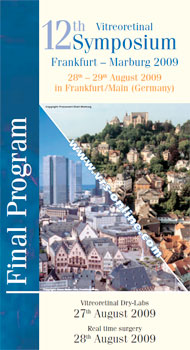12th Vitreoretinal Symposium Frankfurt – Marburg 2009
Scientific programm: Abstract
4th scientific session: Follow ups on Strategies
24. Does Size Really Matter? Combined Anterior and Posterior Segment Surgery
 Peter Senn (Luzern)
Peter Senn (Luzern)
Purpose: To evaluate factors in material and technique that have to be considered when using "microincision" techniques in anterior and posterior segment surgery.
Background: Small incision cataract surgery may have some advantages, compared to the standard 2.75mm phaco approach. After initial enthusiasm for 25g vitrectomy, many surgeons switched to the more universal 23g system. Combining small incision techniques in anterior and posterior segment surgery seems to be logical.
Patients and method: Vitrectomy patients in a public ophthalmic hospital (Lucerne). Prospective studies of defined subgroups. Description of technical modification or limitations.
Results: Over the last 4 years, 49-56% of the vitreous surgery was performed as combined procedure (PPV, Phaco + IOL). In 2008 23g PPV was used in 87%, 25g in 9% and 20g in 4% of the 552 cases. (2007: 24 / 41 / 35%. 2006: 1 / 52 / 47%). Mixed size scleral incisions showed to be useful for complex problems (5000 cps Si-oil removal, endoscopy, endophaco etc.). Seemingly closed sclerotomies were routinely sutured to avoid the complication of subconjunctival Si-oil, as seen in earlier cases. Standard 2.75mm, 2.4mm or Co-Mics 1.8mm phaco was used, depending on the IOL type. Bimanual I-A had to be adapted. The chosen IOLs were stable in airfilled eyes. Posterior capsule opacification developed in 40% >2 years with certain microincision IOLs.
Discussion: Obviously, good clinical results are achievable, using smaller incisions. 23g has become our standard procedure. Modifications, such as enlarging one sclerotomy, suturing sclerotomies in Si-oil cases etc. may be necessary. For the lens part of the combined surgery, the limitating factor is not lens removal (1.8mm works fine), but the type of IOL chosen. In selected cases, the advantage of a minimal size cataract incision may overweight potential disadvantages of certain microincision IOLs (surface material, stability, secondary cataract etc).
Conclusion: Microincision works fine in combined anterior und posterior segment surgery. Offered various techniques, each surgeon has to be aware of possible compromises.
Copyright © VRS-online, 1999-.
All rights reserved. Impressum, rechtliche Hinweise
HTML & Webdesign: SPALLEK.COM
